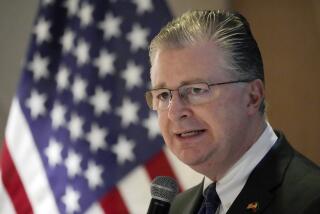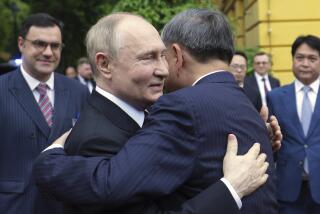U.S. Steps Up Military Linkage to Vietnam
- Share via
WASHINGTON — President Clinton still has a few foreign-policy surprises to pop in his second term, and one is Vietnam.
Over the past few months, with no public announcement of any kind, the Clinton administration has taken small but significant steps toward establishing military ties with Vietnam--that is, the same Hanoi regime with which the United States fought a bloody war three decades ago.
In October, a senior Pentagon official and officers of the U.S. Pacific Command traveled to Hanoi for talks with the Vietnamese defense ministry. Vietnam is said to be preparing to send its first military attache to Washington this spring.
These contacts could be a prelude to an event that would be much more attention-grabbing. Within the next year or two, the U.S. Navy may make its first port call to Vietnam since the days during the war when American warships operated from the mammoth naval installation at Cam Ranh Bay.
The way for the visit was paved last spring, when a Canadian frigate, the Regina, docked on the Saigon River in what was the first visit by a Western naval vessel in Ho Chi Minh City (formerly Saigon) since the end of the war.
An administration source says Vietnam has signaled its willingness to have an American port call, although probably not to Cam Ranh Bay. One possibility envisioned would have the Navy visit Hue, Vietnam’s old imperial capital.
The fledgling military relationship between Washington and Hanoi is being matched in other policy areas too.
Within the next few months, the administration may take steps to enable the Export-Import Bank and the Overseas Private Investment Corp. to start helping American businesses in Vietnam. Eximbank provides federally subsidized loans and loan guarantees to finance the sale of American products, while OPIC insures foreign investment against political risk.
Until now, the Eximbank and OPIC have been blocked from operating in Vietnam by the Jackson-Vanik Amendment. That is the provision of federal law, originally aimed at the Soviet Union, requiring Communist countries to show that they allow freedom of emigration before receiving U.S. economic benefits.
However, after recent talks, the State Department is now said to be nearing an agreement that would let Clinton waive the Jackson-Vanik Amendment for Vietnam--thus opening the way for American companies to widen the scope of business there.
In trade talks, Vietnam is still said to be balking at American requests to open up its economy. But some U.S. officials hope a trade pact with Hanoi will be concluded by the summer. And that accord, in turn, would open the way for Vietnam to obtain most-favored-nation trade benefits so that its products can be imported into the United States at relatively low tariff rates.
In one sense, all of these steps are merely part of the process of establishing with Vietnam the sort of normal, everyday relationship the United States has with other countries. Of course, even to speak of a “normal” American relationship with Vietnam is oxymoronic: The two countries have had the sort of turbulent past of which author Michael Herr once wrote: “Vietnam was what we had instead of happy childhoods.”
In another sense, the administration’s moves to develop ties with Vietnam also are being propelled by larger geopolitical forces, including, notably, the continuing wariness in Washington about China’s power and intentions.
One reason the administration seems to have kept so quiet about the recent military contacts with Vietnam is the desire to avoid irritating Beijing. Chinese leaders have been complaining that U.S. efforts over the past year to upgrade American military alliances with Japan and Australia are part of a supposed strategy to contain China.
At the same time, China has recently been engaged in some of its own strategic diplomacy in Asia. It has taken a series of steps in recent months to strengthen its ties with Russia and India. Look at how China’s top leaders spent their time in late December: President Jiang Zemin traveled to New Delhi, while Premier Li Peng was in Moscow.
In other words, China is securing and stabilizing relations with the countries to its interior in Asia so that it can concentrate on its more contentious, conflict-laden ties with Taiwan, the United States and Japan off its eastern coast.
Chinese foreign policy and East Asian politics in general seem to be in some ways the opposite of what they were a quarter of a century ago. In the late 1960s and early 1970s, China was eager to smooth over its relations with the United States and Japan, the two big countries across the sea, so that Chinese leaders could focus on the threat from the Soviet Union.
Vietnam is, in many ways, a symbol of how U.S. policy and the larger politics of East Asia are changing. And no one in Washington recognizes symbols more quickly than Clinton.
So here’s a prediction of what could well be one of the most dramatic moments of the second Clinton term: Sometime in the next four years, he is going to travel to Vietnam. The president who epitomizes a generation’s divisions over Vietnam is likely to visit the country he didn’t see a quarter of a century ago.
It won’t happen this year. It’s still a bit too soon. But this is the direction where American policy now seems to be leading. Let’s guess it will be Clinton to Hanoi, soon after the congressional elections of 1998.
The International Outlook column appears here every Wednesday.
More to Read
Sign up for Essential California
The most important California stories and recommendations in your inbox every morning.
You may occasionally receive promotional content from the Los Angeles Times.










